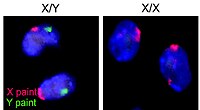
Photo from wikipedia
Differences of sex development are conditions with discrepancies between chromosomal, gonadal and phenotypic sex. In congenital hypogonadotropic hypogonadism, a lack of gonadotropin activity results primarily in the absence of pubertal… Click to show full abstract
Differences of sex development are conditions with discrepancies between chromosomal, gonadal and phenotypic sex. In congenital hypogonadotropic hypogonadism, a lack of gonadotropin activity results primarily in the absence of pubertal development with prenatal sex development being (almost) unaffected in most patients. To expedite progress in the care of people affected by differences of sex development and congenital hypogonadotropic hypogonadism, the European Union has funded a number of scientific networks. Two Actions of the Cooperation of Science and Technology (COST) programmes — DSDnet (BM1303) and GnRH Network (BM1105) — provided the framework for ground-breaking research and allowed the development of position papers on diagnostic procedures and special laboratory analyses as well as clinical management. Both Actions developed educational programmes to increase expertise and promote interest in this area of science and medicine. In this Perspective article, we discuss the success of the COST Actions DSDnet and GnRH Network and the European Reference Network for Rare Endocrine Conditions (Endo–ERN), and provide recommendations for future research. The COST programme funded two European Actions for the systematic elucidation of differences of sex development and congenital hypogonadotropic hypogonadism. In this Perspective article, the authors describe the achievements of these two related COST Actions and highlight the gaps in research.
Journal Title: Nature Reviews Endocrinology
Year Published: 2019
Link to full text (if available)
Share on Social Media: Sign Up to like & get
recommendations!